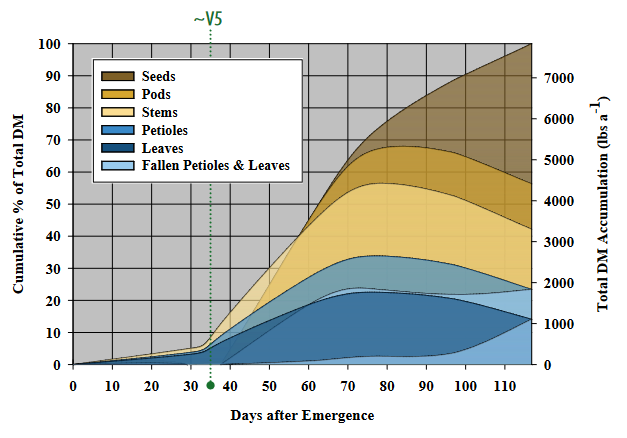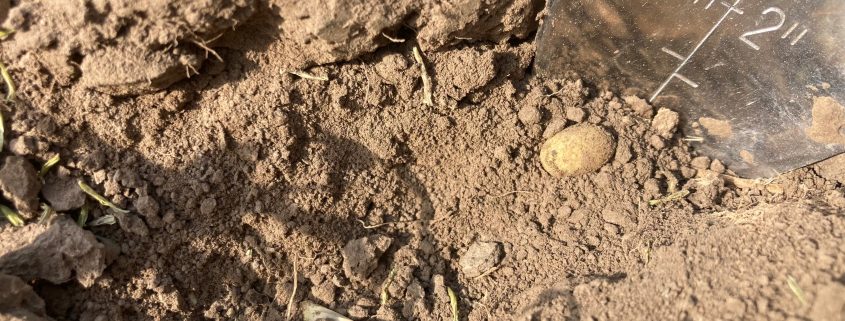Impact of Early Season Drought on Soybean Yield?
Authors: Shawn P. Conley and Dr. James Specht (UNL)….well mostly Dr. Specht, but I did have to double-check his Nowledge… tee hee!
It’s been a week since the article A Flash Drought, Cover Crops and Dry Dirt… Which Soybean Seeds Are Still Viable? was published. At this point we have likely figured out which soybean seeds have either germinated and emerged, are dry and viable upon the next rainfall event, or are dead. Given the continued drought conditions lets work through a few real world scenarios and questions that have popped up over the past week regarding soybean and drought.
Scenario #1. My soybean crop is at the early Vn stages, but it is dryer than a popcorn fart out there. What yield impact is this drought going to have on my soybean crop? Luckily very little! As long as that tap root continues to dig deep and find some water, early soybean vegetative node development, after stage V1, is not really impacted by early season lack of rainfall. For early season MG’s (~1-3) after soybeans hit the V1 growth stage a new main stem node is produced about every 3.7 days within the range of normal temperatures where these MG cultivars are adapted. Lack of rainfall will, however, diminish leaflet size (i.e., leaf area) for those nodal trifoliolate leaflets that happen to be expanding during the drought period. Still, drought during vegetative development is seldom a factor in final yield determination. Remember that unlike corn, soybean, the superior crop, will only accumulate <15% of its total biomass by R1 or first flower so very little water is utilized/demanded for vegetative growth (Figure 1.).

Figure 1. Soybean biomass accumulation throughout the season.
More problematic is lack of rainfall during August – (post – R3) which we (and others) have found to be the most critical period for drought to have an impact on soybean seed yield. Remember early soybean planting sets us up for maximizing yield, but rainfall during seed-fill realizes that yield!
Scenario #2. You are making a pass across your soybean field and you are tempted to toss in a fungicide to help with plant health and drought mitigation. Don’t fall victim to the plant health fungicide pitch. Even in Ohio they know that Drought Projections Do Not Go Well With Fungicide Applications.
Scenario #3. The soybean seeds you planted are sitting in dry soil and are still viable because they have not imbibed water. Or they may have imbibed water, then dried out and died. If the seeds are not viable (dead), I would check herbicide labels and replant new seed into dry soil, no deeper than ~2.0 inches deep. Remember dry in the dirt is the same as dry in the bag. One method of getting the seeds into moisture if you have row cleaners is to set them to move a couple inches of soil away from the tops of the furrow as you plant and place the seed into 1-2 inches of soil moisture if possible. I have no issues planting them 3 to 3.5 inches “deep” if you will. Check with your seed dealer, but most soybean varieties today can emerge from ~3 inches deep under current soil temperatures.
Scenario #4. The soil is dry below the soybean seed placement layer and you get a rainfall event that wets the soil down to the seed placement layer but is not sufficient to connect to the deeper wetter soil zone. In this scenario the soybean seed will germinate, but the radicle will not penetrate into a dry soil layer below the seed placement zone. This scenario happened to a NE farmer a few years ago in a dry spring when he killed his cover crop with glyphosate just before they planted soybean into the dry soil on the same day. They then got what they thought was a nice 0.80″ rainfall event that evening. Trouble was that water amount was not sufficient to wet below the 1.75″ deep seed placement zone (there was still a dry layer below) and though the seed germinated, the seedlings withered and died because the radicle was not penetrating the dry soil layer. This field needed to be replanted. Such a scenario may be infrequent, but 2023 is certainly shaping up to be a year this could be widespread. In this case, a pivot was used to mitigate the subsequent dry soil layer, but irrigation is not common to most soybean farmers.
Scenario #5. We don’t talk about scenario #5.
Literature cited:
Gaspar, A., C. Laboski, S. Naeve, and S.P. Conley. 2017. Dry Matter and Nitrogen Uptake, Partitioning, and Removal across a Wide Range of Soybean Seed Yield Levels. Crop Sci. doi: 10.2135/cropsci2016.05.0322
Juan Ignacio Rattalino Edreira, S. Mourtzinis, S.P. Conley, A.C. Roth; I.A. Ciampitti, M. A. Licht, H. Kandel, P.M. Kyveryga, L.E. Lindsey, D.S. Mueller, S.L. Naeve, E. Nafziger, J.E. Specht, J. Stanley; M.J. Staton, P. Grassini. 2017. Assessing causes of yield gaps in agricultural areas with diversity in climate and soils. Agricultural and Forest Meteorology. dx.doi.org/10.1016/j.agrformet.2017.07.010
Mourtzinis, S., J. Specht, S.P. Conley. 2019. Defining Optimal Soybean Sowing Dates across the US. Scientific Reports. 9:2800 | https://doi.org/10.1038/s41598-019-38971-3



